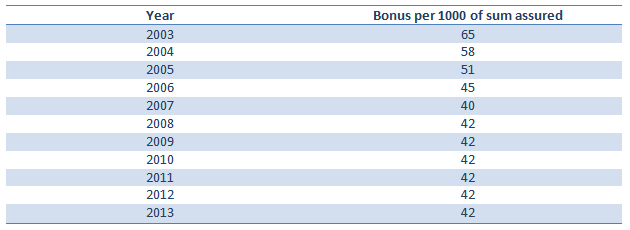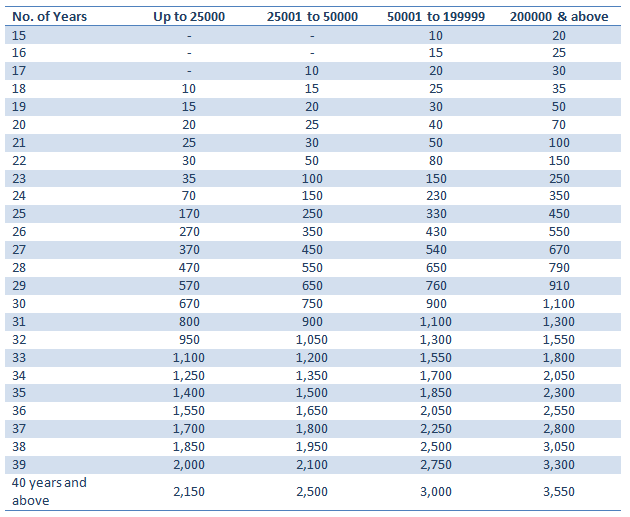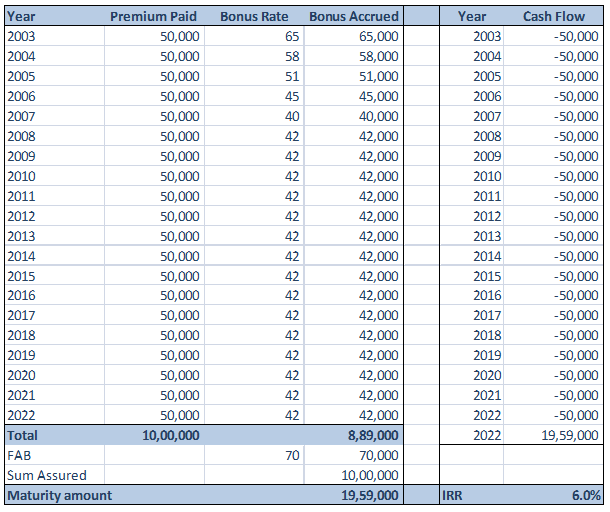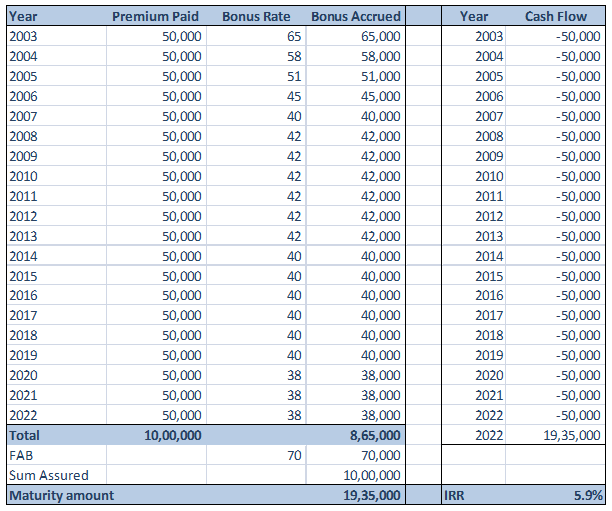Know the returns from your Endowment Life Insurance Policy

Endowment insurance policies have always been very popular in India. The advent of ULIPs had an impact on the popularity of endowment policies, but they still continue to be quite popular. If you had bought your life insurance policy 10 or 15 years back, most probably it would have been an endowment policy. Endowment plans are hybrid life insurance and investment instruments. In the event of an untimely death, at any point of time during the term of the policy, the family of the policy holder gets the insurance cover, also known as sum assured. On maturity, the policy holder gets a guaranteed amount (also known as sum assured) and a bonus amount. In this article we will discuss, how endowment insurance policy holders can calculate the return on their investment. In the case of endowment plans, the investment made by the policy holder is the total premiums paid over the term of the policy. We will discuss how to estimate the maturity amount, with the example of endowment plans from Life Insurance Corporation (LIC). However, you can use this method to calculate returns from endowment plans of other insurance companies, with suitable adjustments.
How do endowment plans generate returns?
A portion of the premium gets allocated towards the sum assured and a portion of the premium is allocated towards the administrative expenses of the insurer. The balance portion of the premium gets invested. The money that is invested generates a certain return every year. This return may be declared as a bonus. The bonus is declared usually as a percentage of the sum assured. The life insurance company may declare bonus every year, but the bonus is not guaranteed. Once declared, this bonus becomes part of the guaranteed benefits of the plan. The bonus is not payable immediately, but accrues every year and becomes payable only at maturity or a death claim.
Types of bonuses
LIC offers three types of bonuses:-
Simple Reversionary Bonus:
Generally when we speak about bonus of an endowment policy, essentially we are speaking about Simple Reversionary Bonus. It is usually declared every year as an amount per thousand of sum assured and accrues throughout the term of the policy. It is payable either on maturity or claim or surrender of the policy. If the policy holder surrenders the policy before completing the full policy term, he/she will not get the full bonus amount. LIC discloses the bonus amount every year. It is available on the LIC website. The most important thing to note about Simple Reversionary Bonus is that it does not compound, it only accumulates.Final Additional Bonus (FAB):
This bonus is paid on certain policies which run for long duration (e.g. 15 years and above, as decided by LIC). This bonus is calculated at the time of maturity or claim. The LIC bonus document contains the information regarding the insurance plans that qualify for FAB, and the FAB amounts by duration and sum assured.Loyalty Additions:
This is loyalty bonus and is paid on certain policies policy holders who have been with LIC for a long time. This bonus is also calculated on per thousand sum assured basis. Usually Loyalty Additions are calculated at the end of the term.
Let us see now with an example, how to calculate the return of your endowment plan. Let us assume you bought an endowment plan in 2002 with a sum assured of Rs 10 lakhs and policy term of 20 years. Let us assume, you were then 30 years old and your premium would be around Rs 50,000 per annum. Further, let us assume you have opted for annual premium payment. Your policy will mature in 2022. Let us estimate what your maturity amount will be in 2022.
The table below shows the bonus declared by LIC since 2003.

The table below shows the Final Additional Bonus (FAB) declared by LIC by duration and sum assured in 2013

Normally policies which have regular bonuses do not have loyalty additions. Let us assume that, this policy does not have loyalty additions.
Let us now estimate what the final maturity amount will be. First we need to forecast, how much bonus LIC will declare on an annual basis, over the balance term of the policy. Over the years the bonus declared by LIC is coming down, as is evident in the table above showing bonuses from 2003 to 2013. In 2003 the bonus was Rs 61 per Rs 1000 of sum assured (SA). In 2013 it is only Rs 42 per Rs 1000 of SA. We will analyze 2 scenarios (you can analyze as multiple scenarios as you want based on your own assumptions).
Scenario 1: Bonus is flat at Rs 42 per Rs 1000 of SA for the balance term of the policy
For the balance term, 2014 to 2022, the bonus will be Rs 42 per Rs 1000 of SA every year. Let us assume the FAB will be Rs 70 per Rs 1000 of SA, as per 2013 rates (see FAB table above). Let us now estimate what the maturity amount will be. See the schedule below.

The maturity amount is Rs 19.59 lakhs. The total premium paid by you is Rs 10 lakhs. Since the investment is made on a periodic (annual) basis, we should use IRR to calculate the returns. The return of the endowment plan in this case is 6%.
Scenario 2: Bonus declines to 40 / 1000 SA from 2014 – 19 and 38 / 1000 SA for the balance term
From 2014 to 2019, let us assume bonus is Rs 40 per Rs 1000 of SA (5% lower than current rates) and Rs 38 per Rs 1000 of SA (10% lower than current rates) from 2020 – 22. FAB will be Rs 70 per Rs 1000 of SA, as per 2013 rates (see FAB table above). Let us now estimate what the maturity amount will be. See the schedule below.

The picture does not change all that much. The maturity amount is Rs 19.35 lakhs and the return is 5.9%. Investors should note that the maturity proceeds are tax free.
Conclusion
Investors, who rely on endowment policies for their retirement planning, will probably realize that the maturity proceeds will not be enough for their retirement and therefore can plan accordingly. It is important that investors clearly know what to expect from their endowment policies, so that they can go about their financial planning in a thoughtful way.
Queries
-
What is the benefit of mutual fund STP
Aug 29, 2019
-
How much to invest to meet target amount of Rs 2 Crores
Aug 26, 2019
-
Can I achieve my financial goals with my current mutual fund investments
Aug 24, 2019
-
Can you tell me return of various indices
Aug 19, 2019
-
What would be the post tax return on different investments
Aug 18, 2019
-
Which Principal Mutual Fund scheme will be suitable for my retirement corpus
Aug 16, 2019
-
What is the minimum holding period for availing NCD interest
Aug 4, 2019
Top Performing Mutual Funds
Recommended Reading
Fund News
-
Kotak Mahindra Mutual Fund launches Kotak Nifty200 Value 30 Index Fund
Jan 15, 2026 by Advisorkhoj Team
-
Bandhan Mutual Fund launches Bandhan Silver ETF FOF
Jan 12, 2026 by Advisorkhoj Team
-
Bandhan Mutual Fund launches Bandhan Gold ETF FOF
Jan 12, 2026 by Advisorkhoj Team
-
The Wealth Company Mutual Fund launches The Wealth Company Gold ETF FOF
Jan 9, 2026 by Advisorkhoj Team
-
Mahindra Manulife Mutual Fund launches Mahindra Manulife Innovation Opportunities Fund
Jan 9, 2026 by Advisorkhoj Team














